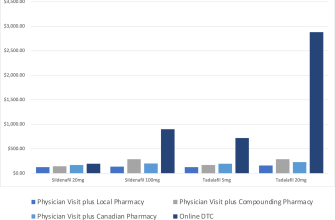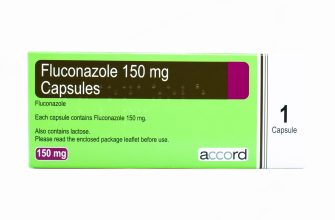For those considering Citalopram hydrobromide as a treatment option, choosing the generic version can provide both cost savings and comparable efficacy. This selective serotonin reuptake inhibitor (SSRI) is primarily prescribed for depression and anxiety disorders, working to balance serotonin levels in the brain, which promotes mood stabilization.
When evaluating the generic form, it’s essential to ensure that you’re getting a product manufactured by a reputable company. Looking for certifications from recognized health authorities can help confirm quality and safety. Dosage forms typically range from 10 mg to 40 mg, allowing for tailored treatment plans based on individual health needs.
While Citalopram can be highly effective, it’s important to consult with your healthcare provider regarding potential side effects, such as nausea or dizziness. Understanding the full spectrum of effects and how the medication may interact with other treatments can optimize your mental health strategy.
- Citalopram Hydrobromide Generic
- Benefits of Generic Citalopram
- Usage Guidelines
- Understanding Citalopram Hydrobromide: Uses and Benefits
- Comparing Brand-Name and Generic Versions of Citalopram
- Cost Considerations
- Regulatory Standards
- Dosage Guidelines for Citalopram Hydrobromide
- Side Effects and Risks Associated with Citalopram
- Drug Interactions: What You Need to Know
- Common Drug Interactions
- Alcohol and Recreational Drugs
- Patient Experience: Managing Treatment with Citalopram
Citalopram Hydrobromide Generic
Citalopram hydrobromide offers a reliable option for managing depression and anxiety disorders. Available as a generic medication, it ensures accessibility without compromising quality. Many patients benefit from its effectiveness and affordability.
Benefits of Generic Citalopram
- Cost-effective alternative to brand-name medications.
- Same active ingredient, ensuring similar efficacy.
- Widely researched and trusted by healthcare professionals.
Usage Guidelines
- Follow your healthcare provider’s dosage recommendations.
- Take the medication consistently at the same time each day.
- Be aware of possible side effects such as nausea, fatigue, or dry mouth.
Consult your doctor before starting or discontinuing use. Regular check-ins can help monitor progress and manage any side effects effectively.
Understanding Citalopram Hydrobromide: Uses and Benefits
Citalopram hydrobromide is an antidepressant primarily prescribed for major depressive disorder. It belongs to the selective serotonin reuptake inhibitors (SSRIs) class. This medication works by increasing the levels of serotonin in the brain, leading to improved mood and emotional well-being.
Here are the key uses and benefits of citalopram hydrobromide:
- Depression Management: Citalopram effectively alleviates symptoms of depression, helping patients feel more balanced and engaged in daily activities.
- Anxiety Reduction: Many patients experience reduced symptoms of anxiety, making it easier to handle stress and social situations.
- Long-term Treatment: This medication can be used as a long-term treatment option, providing sustained relief from depressive symptoms.
- Minimal Sedation: Unlike some other antidepressants, citalopram tends to cause less sedation, allowing individuals to maintain their daily routines without significant drowsiness.
- Once-Daily Dosing: The convenience of taking citalopram once a day improves adherence, making it easier for patients to stick to their treatment plan.
Monitoring is vital while on this medication. Regular consultations with a healthcare provider can optimize the treatment and address any concerns. Those starting citalopram may notice positive changes within a few weeks, but it’s important to continue taking the medication as prescribed, even if improvements appear early.
Potential side effects, like nausea, dry mouth, or changes in weight, should be discussed with a healthcare provider. Open communication ensures that the benefits of citalopram outweigh any drawbacks, leading to better overall mental health.
Comparing Brand-Name and Generic Versions of Citalopram
Choose between brand-name Citalopram and its generic counterpart carefully. Both versions contain the same active ingredient, ensuring similar therapeutic effects for managing depression and anxiety. However, variations in inactive ingredients may affect tolerability for some individuals. It’s wise to consult your healthcare provider if you notice different reactions when switching between the two.
Cost Considerations
Generic Citalopram typically offers significant cost savings over the brand name. Prices can vary based on insurance coverage and pharmacy, but generics generally present a more affordable option without compromising quality. Consider shopping around and checking medication prices at different pharmacies for the best deal.
Regulatory Standards
The FDA mandates that generics meet strict guidelines to ensure they are bioequivalent to their brand-name counterparts. This means that generics must match the brand in dosage, strength, and form, leading to similar absorption and effect. Trust the generic label knowing it meets these rigorous standards, making it a reliable choice for treatment.
Dosage Guidelines for Citalopram Hydrobromide
The typical starting dose of citalopram hydrobromide is 20 mg, taken once daily. For patients who may benefit from increased dosage, healthcare providers may adjust the dose after a minimum of one week.
Dose adjustments should be made carefully, and the maximum recommended dose should not exceed 40 mg per day. Elderly patients and those with liver impairment should receive cautious dosage adjustments, starting at 10 mg and not exceeding 20 mg.
| Condition | Recommended Dosage |
|---|---|
| Adults | Initial: 20 mg/day; Max: 40 mg/day |
| Elderly | Initial: 10 mg/day; Max: 20 mg/day |
| Liver Impairment | Initial: 10 mg/day; Max: 20 mg/day |
Consistency is key. Take citalopram at the same time each day to maintain even levels in your system. If a dose is missed, take it as soon as remembered, unless it’s almost time for the next dose. In that case, skip the missed dose and resume the regular schedule. Never double doses.
Monitor for side effects, particularly during the initial weeks of treatment. Consult with a healthcare professional regarding any concerns or unusual responses. Regular follow-up appointments help assess the effectiveness of the treatment and make any necessary adjustments.
Side Effects and Risks Associated with Citalopram
Citalopram can lead to several side effects that patients should be aware of. Common effects include nausea, dry mouth, fatigue, and headaches. While these symptoms may dissipate over time, they can be bothersome during the initial treatment phase.
Serious risks include an increased likelihood of suicidal thoughts, particularly in younger individuals. It’s crucial for patients to have regular check-ins with their healthcare provider to monitor mood changes and discuss any emerging thoughts of self-harm.
Another important consideration is the potential for serotonin syndrome, a rare but serious condition that arises from excessive serotonin levels. Symptoms may include confusion, agitation, rapid heart rate, or increased sweating. If these occur, seek immediate medical attention.
Some patients may experience withdrawal symptoms upon discontinuation of Citalopram, including dizziness, irritability, or sleep disturbances. A gradual tapering of the dosage, under medical supervision, can help mitigate these risks.
Interaction with other medications is another concern. Combining Citalopram with other serotonergic drugs can heighten the risk of serotonin syndrome. It’s vital to inform your healthcare provider of all medications being taken.
Pregnant or breastfeeding individuals should discuss potential risks with their doctor, as the medication may affect the unborn child or nursing infant.
Regular monitoring and open communication with a healthcare provider enable better management of these risks. Being proactive about your health contributes significantly to your overall well-being while on Citalopram.
Drug Interactions: What You Need to Know
Citalopram hydrobromide may interact with several medications and substances, potentially altering its effects or increasing side effects. Always inform your healthcare provider about all medications, supplements, and herbal products you are taking.
Common Drug Interactions
Some medications that can interact with citalopram include:
- Monoamine oxidase inhibitors (MAOIs): Combining citalopram with MAOIs can lead to serious side effects, including serotonin syndrome. Maintain a minimum of 14 days between stopping an MAOI and starting citalopram.
- Anticoagulants and antiplatelet drugs: Citalopram may increase bleeding risk when taken with medications like warfarin or aspirin. Monitor for unusual bruising or bleeding.
- Other antidepressants: Combining citalopram with other SSRIs, SNRIs, or tricyclic antidepressants could elevate serotonin levels, leading to serotonin syndrome symptoms.
Alcohol and Recreational Drugs
Limit alcohol consumption while taking citalopram. Alcohol can enhance side effects such as drowsiness and dizziness. Recreational drugs may also interfere with citalopram’s effectiveness and increase the risk of side effects; consult a healthcare provider for guidance.
Regularly review your medications with your healthcare provider to ensure safety and efficacy. If you notice any unusual symptoms, seek medical advice immediately.
Patient Experience: Managing Treatment with Citalopram
Take citalopram consistently at the same time every day to maintain stable levels in your system. Establish a routine that fits seamlessly into your daily life, whether it’s in the morning, afternoon, or evening.
Monitor how you feel after starting the medication. Track mood changes, anxiety levels, and any side effects in a journal. This can help you and your healthcare provider make necessary adjustments.
Stay in touch with your healthcare provider, especially during the first few weeks. Schedule regular check-ins to discuss your progress. Don’t hesitate to ask questions or voice concerns about your treatment.
Understand that side effects, such as nausea or fatigue, may occur initially. These often improve over time. If side effects persist or worsen, consult your doctor for guidance.
Do not stop taking citalopram abruptly. Gradual tapering is crucial to prevent withdrawal symptoms. Discuss a tapering plan with your healthcare provider if you need to discontinue use.
Engage in supportive activities. Regular exercise, a balanced diet, and mindfulness practices can enhance your emotional well-being while on medication.
Join support groups or speak with others experiencing similar challenges. Sharing insights and coping strategies can be beneficial and provide a sense of community.
Be patient as your body adjusts. It may take several weeks to notice significant improvements. Stay committed to your treatment plan for the best outcomes.
Educate yourself about citalopram. Understanding the medication can empower you and alleviate fears. Reliable sources include healthcare providers and reputable online platforms.
Consider keeping a list of your medications and any supplements. This can help avoid potential interactions and serves as a handy reference for discussions with healthcare providers.
Prioritize self-care. Establishing good sleep habits and engaging in activities you enjoy can significantly improve your overall mental health while undergoing treatment with citalopram.








